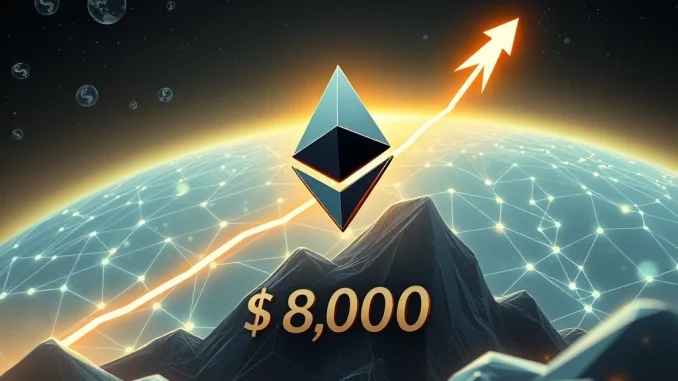
The cryptocurrency world is buzzing with renewed optimism as analysts forecast a potential surge for Ethereum, with some eyeing an astonishing $8,000 target. This ambitious prediction isn’t just wishful thinking; it’s rooted in a compelling convergence of macroeconomic trends and the undeniable strength of the Ethereum ecosystem. For anyone tracking the Ethereum price, understanding these underlying forces is crucial.
How Does M2 Growth Fuel Ethereum’s Potential?
At the heart of this bullish outlook lies the concept of M2 money supply growth. M2 is a broad measure of a nation’s money supply, encompassing cash, checking deposits, and easily convertible near-money assets. When central banks expand the M2 money supply, it generally means more liquidity is flowing into the global economy. Traditionally, this liquidity seeks out assets that can preserve or grow value, especially in an inflationary environment.
Liquidity Absorption: Crypto entrepreneur Ted Pillows highlighted Ethereum’s unique ability to absorb this expanding global liquidity. Unlike traditional fiat currencies, which can depreciate with oversupply, Ethereum’s design offers a compelling alternative.
Deflationary Mechanisms: A key differentiator for Ethereum is its deflationary structure, notably the EIP-1559 fee-burning model. A portion of transaction fees is permanently removed from circulation, reducing the overall supply. This scarcity, combined with capped issuance, positions Ethereum as a potential hedge against inflation, drawing in investors looking for alternatives to traditional assets that are diluted by increasing M2 growth.
This interplay between macroeconomic conditions and Ethereum’s valuation forms the core argument for the $8,000 target. As Eric Trump acknowledged, if current trends of monetary expansion persist, the flow of capital into robust, deflationary digital assets like Ethereum could indeed make such a valuation plausible.
The Unstoppable Force: Ethereum Ecosystem Strength
Beyond macroeconomic tailwinds, the inherent strength and continuous evolution of the Ethereum ecosystem provide a robust foundation for its growth narrative. Ethereum isn’t just a cryptocurrency; it’s the foundational layer for much of the decentralized internet, or Web3.
Decentralized Applications (dApps): Ethereum continues to be the leading platform for dApps, ranging from gaming to identity management, driving widespread adoption and utility.
Decentralized Finance (DeFi): Ethereum remains the undisputed leader in DeFi. Its Total Value Locked (TVL) in various protocols reflects immense investor confidence and liquidity. This vibrant DeFi landscape continually innovates, offering new financial services without intermediaries.
Non-Fungible Tokens (NFTs): The explosion of NFTs largely originated and continues to thrive on Ethereum, creating new digital economies and fostering artistic expression and ownership.
Developer Activity & Adoption: Consistent high levels of developer activity and increasing active addresses signal sustained innovation and real-world adoption. This vibrant community ensures continuous improvements and new use cases.
Proof-of-Stake Transition: The successful transition to a proof-of-stake (PoS) consensus model has dramatically enhanced Ethereum’s energy efficiency, making it a more sustainable investment. Furthermore, it introduced new staking mechanisms that contribute to its deflationary supply dynamics, making the network more secure and economically attractive.
These factors collectively solidify Ethereum’s role as the cornerstone of the Web3 economy, providing tangible utility and a compelling value proposition that goes far beyond speculative trading, directly impacting the potential for the Ethereum price to climb.
What Challenges Lie on the Path to ETH $8000?
While the outlook for Ethereum is overwhelmingly positive, the journey to ETH $8000 is not without its hurdles. Investors must remain cognizant of potential headwinds that could influence its trajectory:
Regulatory Uncertainties: The evolving regulatory landscape across major global markets poses a significant challenge. Unclear or restrictive policies could dampen investor enthusiasm and innovation.
Competitive Landscape: While Ethereum dominates, competitors like Solana, Avalanche, and others are actively gaining traction, particularly among developers seeking alternative blockchain environments. These networks offer different trade-offs in terms of speed, cost, and decentralization.
Scalability Concerns: Despite significant advancements with layer-2 solutions (like Optimism, Arbitrum, zkSync) and upcoming sharding upgrades, scalability remains a persistent concern for mass adoption. High gas fees during peak network congestion can still deter new users and small transactions.
Macroeconomic Shifts: Broader economic conditions, such as sudden interest rate hikes by central banks or a global economic downturn, could reduce overall risk appetite, potentially impacting investment in volatile digital assets like Ethereum.
Balancing optimism with a realistic assessment of these challenges is key for any investor looking at Ethereum’s long-term potential in the crypto market.
Strategic Investing in the Crypto Market: Navigating Volatility
For investors evaluating Ethereum’s potential surge, a balanced and informed approach is paramount. The crypto market is inherently volatile, and while the long-term outlook for Ethereum appears strong, short-term fluctuations are inevitable.
Dollar-Cost Averaging (DCA): Instead of attempting to time the market, consider dollar-cost averaging. This involves investing a fixed amount regularly, regardless of the price, which helps mitigate risk during volatile periods.
Diversification: While Ethereum is a strong contender, diversifying your portfolio across various crypto assets can help spread risk and capture opportunities in other promising sectors.
Continuous Monitoring: Stay informed about technological advancements within the Ethereum ecosystem (e.g., further upgrades, layer-2 developments), regulatory shifts, and global liquidity trends. Informed decision-making is your best asset.
Risk Management: Only invest what you can afford to lose. Understand that even with strong fundamentals, digital assets carry inherent risks.
The convergence of expanding global liquidity, Ethereum’s robust deflationary structure, and its foundational role in the burgeoning blockchain ecosystem presents a compelling case for significant price appreciation. While the $8,000 target remains a forecast rather than a certainty, the underlying fundamentals suggest Ethereum is exceptionally well-positioned to benefit from evolving investor behavior and macroeconomic conditions. As the digital asset landscape matures, Ethereum’s continued ability to adapt, innovate, and maintain its leadership will be the defining factor in its future trajectory and its journey towards higher valuations.
Frequently Asked Questions (FAQs)
1. What is M2 growth and how does it affect Ethereum’s price?
M2 growth refers to the expansion of a country’s money supply, including cash, checking deposits, and easily convertible assets. When M2 grows, there’s more liquidity in the system. This excess liquidity often seeks out assets that can preserve or grow value, especially those with scarcity and deflationary properties like Ethereum, potentially driving its price up.
2. How does Ethereum’s deflationary mechanism work?
Ethereum became deflationary primarily due to the EIP-1559 upgrade, which introduced a base fee for transactions that is ‘burned’ (permanently removed from circulation) instead of going to miners. This mechanism, combined with the reduction in new ETH issuance post-Merge, creates a scenario where more ETH can be burned than created, leading to a net reduction in supply over time.
3. What makes the Ethereum ecosystem so strong?
The Ethereum ecosystem’s strength stems from its dominant position in decentralized applications (dApps), decentralized finance (DeFi), and non-fungible tokens (NFTs). It boasts the largest developer community, highest Total Value Locked (TVL) in DeFi, and continuous innovation, making it the core infrastructure for Web3.
4. What are the main challenges for Ethereum to reach $8,000?
Key challenges include regulatory uncertainties in major markets, increasing competition from other Layer 1 blockchains like Solana and Avalanche, persistent scalability concerns (despite ongoing upgrades), and broader macroeconomic shifts that could impact investor risk appetite.
5. Is investing in Ethereum a good idea now, given the $8,000 prediction?
While the $8,000 prediction highlights strong potential, investing in Ethereum, like any cryptocurrency, carries risks. It’s crucial to conduct your own research, consider strategies like dollar-cost averaging, diversify your portfolio, and only invest what you can afford to lose. The prediction is a forecast, not a guarantee.



